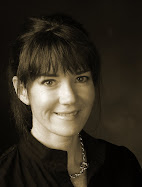I have always loved console tables. This Miles Redd vignette reminds me why…. They offer the perfect opportunity for still life, a chance to pause and soak in the moment. Generally, more about form than function, these narrow platforms can be used in almost any room of the house to display a beloved collection or virtually any other thoughtful arrangement of interesting objects. Often, the status of even the most mundane items can be elevated by including them in a place of honor atop a console table.
Well suited for symmetrical arrangements, console displays frequently feature a pair of lamps at each end with a mirror centered above and a “centerpiece” item. This picture from a real estate listing substitutes the lamps with ivy standards and the centerpiece looks to be an antique humidor (I’ve used a humidor as the centerpiece on my own entry table and love the simplicity of it.)
In this entry, designer Ashley Whittaker uses a pair of very simple gold candlestick lamps with an equally understated mirror, letting a trio of blue and white urns make the statement. I think console tables, particularly those with more delicate lines, look best when they have something tucked below to ground or connect them to the floor plane, as the two larger urns do here.
Once again, a blue and white themed entry, no lamps, instead a pair of tall vases with a centerpiece of pinecones (one of my favorite fall/winter “go-to” bowl fillers.)
Charlotte Moss’ Study. I am always looking for a way to deal with the ridiculous number of shelter magazines I receive each month. Although mostly newspapers, this brilliant solution would work equally well with magazines and look cool doing it! (Okay, that was mostly about the rods, not the console, but it’s sort-of related….)
(Image via Cote de Texas)
Speaking of storage, magazines aren’t the only things piling up around here. With so many fabulous design books published in the past few years, the stacks are getting out of control. Here’s a solution that I have “borrowed” from designer Anne Coyle, with the hope that I’ll come off as more of a scholar than a pack rat. Notice how, by leaning the mirror and artwork, rather than hanging it, the console is physically and visually connected to the wall behind. Also noteworthy; the mirror is angled just “so” to reflect the lovely chandelier in the background, effectively making it part of the tablescape. (And, yes, the use of that term does make me cringe a bit since having been adopted by Sandra Lee.) This collection of books, artwork and objects appears to be casually placed, but it takes a trained eye to get this type of asymmetrical arrangement right.
Another asymmetrical design; I think the placement of the artwork behind the bust is well thought out and very clever.
New Orleans designer, Ned Marshall expands the footprint of this arrangement by flanking the console display with a pair of side chairs and framed artwork. This time the table is anchored by an ancient statuary foot—very chic.
This space, designed by Shannon Bowers, illustrates how a console table can be the perfect solution to “that space under the stairway.” The antique ceiling tiles make for a highly textural and interesting wall display. Note how closely they are hung to the table, tying all the pieces together.
In his own home, Vincente Wolf juxtaposes a very classic and ornate marble-topped Louis XVI console with what looks to be a collection from the Museum of Natural History. Now that is a display that would make me do a double take.
Quiet and lovely, this is how a master styles a console table. In this space designed by John Saladino, the gorgeous antique mirror is the star of the show. He uses one of my favorite “under-table” treatments--a petite bench.
I know this cover image from Veranda has been seen a lot, but it’s so pretty, it deserves a second (or third, or fourth) look. This time, the objects play a supporting role to that beautiful Rococo table.
A console table in a dining room is a natural fit. When needed, it can be called into service to provide extra serving space for large gatherings. In “times of peace” they dutifully supply a pedestal upon which to display a special piece of china or collection of crystal or perhaps a set of pretty candlesticks…. Rather than using a pair of lamps on the tabletop, sconces flanking the mirror allow for an easy transition between uses.
In this Malibu home, Lawrence Rizkowsky uses a console as a bar table of sorts. The show stopping root mirror reflects a lovely scene—the chandelier, the stone mantle topped with a pair of demijohns glowing with the light from an iron sconce—this is such a soothing scene to me.
A console table can be an excellent addition to an outdoor space. The composition is the same, the elements selected to suit the environment.
A console table is a blank canvas, just waiting to be brought to life by a savvy homeowner or designer. Easily re-fashioned to suit a season or a whim, a console can often be incorporated into even the smallest of spaces, showcasing a collection or unifying a mishmash of bits and bobbles. Whether doing double duty as a bar or buffet, or simply providing a beautiful moment of still-life, I think console tables are a great addition to almost any room.




































































































